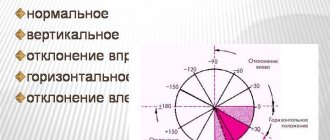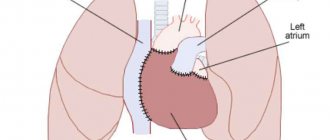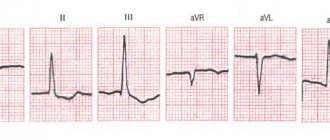Electrocardiogram when the heart rotates around the longitudinal axis
When the heart rotates clockwise around its longitudinal axis (as viewed from the apex), the right ventricle moves forward and upward, and the left ventricle moves backward and downward.
This position is a variant of the vertical position of the heart axis. In this case, a deep Q wave appears on the ECG in lead III, and occasionally in lead aVF, which can simulate signs of focal changes in the posterior phrenic region of the left ventricle. At the same time, a pronounced S wave is detected in leads I and aVL (the so-called QIII SI syndrome). There is no q wave in leads I, V5 and V6. The transition zone may shift to the left. These changes also occur with acute and chronic enlargement of the right ventricle, which requires appropriate differential diagnosis.
The figure shows an ECG of a healthy 35-year-old woman with an asthenic build. There are no complaints about dysfunction of the heart and lungs. There is no history of diseases that could cause hypertrophy of the right heart. Physical and x-ray examination revealed no pathological changes in the heart and lungs.
The ECG shows the vertical position of the atrial and ventricular vectors. Â P = +75°. Â QRS = +80°. Noteworthy are the pronounced q waves along with tall R waves in leads II, III and aVF, as well as S waves in leads I and aVL. Transition zone in V4-V5. The indicated ECG features could provide grounds for determining hypertrophy of the right heart, but the absence of complaints, anamnesis data, and the results of clinical and X-ray examinations allowed us to exclude this assumption and consider the ECG to be a normal variant.
The rotation of the heart around the longitudinal axis counterclockwise (i.e., with the left ventricle forward and upward), as a rule, is combined with deviation of the apex to the left and is a rather rare variant of the horizontal position of the heart. This variant is characterized by a pronounced Q wave in leads I, aVL and left chest along with pronounced S waves in leads III and aVF. Deep Q waves may mimic signs of focal changes in the lateral or anterior wall of the left ventricle. The transition zone with this option is usually shifted to the right.
A typical example of this variant of the norm is the ECG shown in the figure of a 50-year-old patient with a diagnosis of chronic gastritis. This curve shows a pronounced Q wave in leads I and aVL and a deep S wave in lead III.
“Practical electrocardiography”, V.L. Doshchitsin
In some cases, variants of a normal ECG associated with different positions of the heart axis are mistakenly interpreted as a manifestation of one or another pathology. In this regard, we will first consider the “positional” variants of a normal ECG. As mentioned above, healthy people may have a normal, horizontal or vertical position of the electrical axis of the heart, which depends on body type, age and...
A normal ECG with a horizontal position of the electrical axis of the heart must be distinguished from signs of left ventricular hypertrophy. When the electrical axis of the heart is vertical, the R wave has a maximum amplitude in leads aVF, II and III; in leads aVL and I, a pronounced S wave is recorded, which is also possible in the left chest leads. ÂQRS = + 70° – +90°. Such...
Posterior rotation of the heart is accompanied by the appearance of a deep S1 wave in leads I, II and III, as well as in lead aVF. A pronounced S wave may also be observed in all chest leads with a shift of the transition zone to the left. This variant of a normal ECG requires differential diagnosis with one of the ECG variants for right ventricular hypertrophy (S-type). The picture shows...
Premature or early repolarization syndrome is a relatively rare variant of a normal ECG. The main symptom of this syndrome is ST segment elevation, which has a peculiar shape of a convex downward arc and begins from a high J point on the descending knee of the R wave or on the terminal part of the S wave. A notch at the point of transition of the QRS complex to the descending ST segment ...
Peculiar ECG changes are observed in individuals with dextrocardia. They are characterized by the opposite direction of the main teeth compared to the usual one. Thus, in lead I, negative P and T waves are detected, the main wave of the QRS complex is negative, and a QS type complex is often recorded. Deep Q waves may be observed in the chest leads, which may give rise to erroneous diagnosis of large-focal changes...
Source: www.medkursor.ru
Distinctive signs of dizziness
The content of the article
Dizziness can occur for various reasons. If it occurs only once, it may indicate poor health, which will pass after some time. In the case when such a symptom occurs repeatedly, a mandatory consultation with the attending physician and a more comprehensive examination is required to determine the cause of the negative symptoms.
If a patient experiences dizziness when taking a horizontal position, this may indicate pathological changes in his body, which are very important to identify in a timely manner and begin to treat correctly. In a supine position, this condition is detected by the following signs:
- a feeling of the movement of things around, a change in the spatial position of the ceiling or walls;
- very often, with regular attacks, a person experiences a persistent feeling of anxiety before going back to bed;
- a feeling of rotation of one’s own body (sometimes it haunts a person even at night), begins to feel sick when lying down;
- Vomiting and pain in the head appear.
In addition, the attack may intensify with a change in position - turning the head, a sudden change in body position. Increasing the symptom can provoke increased weakness, which haunts the person throughout the day.
↑ Coriolis effect
In physics, the Coriolis effect
is the obvious deviation of moving objects when viewed from a rotating frame of reference. As an example, consider two children on opposite sides of a rotating carousel throwing a ball to each other (Figure 1). From these children's point of view, the ball's path is bent sideways by the Coriolis effect. From the thrower's perspective, this deflection is directed to the right as the carousel rotates counterclockwise (as viewed from above). Accordingly, when moving clockwise, the deflection is directed to the left.
If you are really interested in a detailed explanation of the Coriolis effect, enter “Coriolis effect” into a search engine and study this issue thoroughly.
Turn
Before starting to study new material, let's repeat that if each point of a plane is associated with some point of the same plane, and any point of the plane is associated with a certain point, then they say that a mapping of the plane onto itself is given.
Let us remember that the motion of a plane is a mapping of the plane onto itself, preserving distances.
We have already met and repeated some types of movement: such as axial symmetry, central symmetry, parallel translation.
Today in the lesson we will get acquainted with another type of mapping a plane onto itself - rotation.
Let's mark an arbitrary point O on the plane, call it the center of rotation, and set the angle α (let's call it the angle of rotation).
Rotation of the plane around point O by angle α is the mapping of the plane onto itself, in which each point M is mapped to a point M1 such that the angle MOM1=α. Note that point O remains in place, that is, in other words, it is mapped onto itself, and all other points rotate around point O, and if , then counterclockwise, if , then clockwise
Sometimes in the literature you can find the following notation for rotation around the center O and through the angle α: .
Now let's try to determine whether the turn will be a movement? To do this, it is enough to show that when turning, the distance between the points is maintained.
Let point O be the center of rotation, and angle α be the angle of rotation.
Let's consider the case when α>0, that is, we will rotate counterclockwise relative to point O. The case when α<0, that is, the case when we turn clockwise, is considered similarly; you can do this yourself.
Let, during this rotation, points M and N be mapped to points M1 and N1, respectively. Consider triangles OMN and OM1N1.
,
, in other words, when rotating, the distance between points is maintained. This means turning is another type of movement. It can be imagined as a rotation of the entire plane around a given point O by a given angle α.
Task.
Construct a segment that is obtained from a segment by rotating around a given center by:
a B C) .
Solution.
To rotate a segment, rotate the ends of this segment. In order to rotate point A, we construct a straight line OA. From point O, using a protractor, we mark 150° (we remember that if the angle is less than 0, then we turn it clockwise, that is, we will put the angle in this direction). Using a compass, we measure the distance AO and plot this distance on the resulting straight line.
Let's put point A1. Similarly, let's construct point B1. Then the resulting segment A1B1 is the required one. In order to perform a 100° turn, you need to move 100° counterclockwise.
All other constructions are carried out in the same way as we did in the first paragraph. When rotated by 180°, point A1 will lie on the continuation of straight line OA. Point B1 will lie on the continuation of straight line OB.
Task.
Construct a triangle that is obtained from this triangle by rotating around:
a) points on,
b) around a point not lying inside the triangle on,
c) around a point lying inside the triangle on .
Solution.
We will build a triangle by points. Since the center of rotation is point A, it maps onto itself. Let's display point B. From point A we'll set an angle equal to 80° counterclockwise. Let us plot a segment equal to side AB on this straight line and obtain point B1. Let's similarly construct point C1. Then triangle AB1C1 is the desired one.
Carrying out similar constructions, we will construct triangles A1B1C1 for the remaining two cases.
Today we are finishing our study of the topic Movement. Let's remember once again what movement is and what types of movement we have become familiar with.
The movement of a plane is a mapping of the plane onto itself, preserving distances.
We have proven that the movements are: axial symmetry, central symmetry, parallel translation and rotation.
↑ Direction of rotation of chakras
Peter Kalder did not describe the direction of movement of the vortices (chakras):
I wonder if Calder deliberately avoided mentioning the counterclockwise direction? According to Barbara Ann Brennan, a former NASA scientist and authority on human energy, healthy chakras should rotate clockwise; and closed, unbalanced ones are counterclockwise.
In her successful book, Hands of Light, she says:
When the chakras rotate counterclockwise, there is an outflow of energy from the body, causing metabolic disorders. In other words, when the chakra rotates counterclockwise, we do not receive the energy we need, which we perceive as psychological reality. Such a chakra is considered closed to incoming energy.”
↑ Possible influences of traditions
↑ (a) Traditional Tibetan “trul-hor” yantra yoga
Chogal Namhai Norbu
, one of the great masters of Dzogchen and Tantra, was born in Tibet in 1938.
His book Yantra Yoga: Tibetan Yoga of Movement
was published by Snow Lion Publishing House.
"Trul-hor" means "magic wheel"
, says Alejandro Chaul-Reich, a faculty member at the Ligmincha Institute and an assistant professor at the University of Texas Medical School. He says:
Ryan Parker
specialist in
the Five Tibetan Rituals
, currently conducting research comparing the Five Rituals and the Trul-Khor. According to Peter Kelder in The Eye of Revelation, the rituals, like the trul-khor, date back about 2,500 years.
In his latest Comparative Table he states:
↑ (b) Pradakshina
Throughout history, Tibet and India exchanged ancient knowledge, and it is possible - but not proven - that the First Ritual may have been influenced by the practice of Pradakshina.
In Hinduism Pradakshina
means the act of worship - walking clockwise around a holy place, temple, shrine. Dakshina means right, so you go to the left, with the spiritual object always on your right.
During Pradakshina, you walk clockwise around a temple, shrine, person, mountain, place or even yourself. Hindu temples even have special passages so that people can perform these movements around them in a clockwise direction.
The purpose of such circular movements is to focus or purify oneself, or to honor the object of worship.
Circling is so common that it is found in the cultures of the Greeks, Romans, Druids and Hindus. This is usually associated with a sacrifice or purification process. The interesting thing is that for all these cultures the direction of movement is always the same - clockwise!
Reasons for the occurrence of the violation
If a person suddenly begins to feel dizzy, then he needs to change his position to horizontal as soon as possible. Most often, after this, unpleasant symptoms quickly disappear, fear goes away, and consciousness becomes clear.
Severe dizziness in a lying position may indicate particularly dangerous disorders in the patient’s body. Factors in the development of this condition may be:
- Arterial hypertension. The disease is accompanied by an increase in blood pressure, especially in the morning, when a person experiences a surge in hormonal activity. Indicators exceeding 170/100 millimeters of mercury cause ischemia of the brain centers and heart.
- Osteocondritis of the spine. With this disease, the nutrition of the intervertebral discs deteriorates, which results in a change in their elasticity.
- Mier's disease occurs due to ischemia of the structure of the inner ear, vestibular, and also the auditory nerve. In this case, the patient complains of gagging, dizziness and lack of coordination in space.
- Internal otitis (labyrinthitis), ear injuries. In this case, there is a disruption in the conduction of impulses to the vestibular centers. Even when the patient is in a horizontal position, there is a feeling of pain in the ears, nausea and dizziness before the eyes.
- Brain tumors, classified as malignant and benign, provoke tissue compression. The patient experiences severe pain in the head, vomiting, and decreased visual acuity. Dizziness usually occurs at night. You feel dizzy when lying on your back, and there is a feeling of a change in body position.
- The use of sedatives and sleeping pills often negatively affects the functioning of the brain. This is especially pronounced in women, who are characterized by a surge in hormone levels. After waking up, a person has a feeling of nausea, dizziness begins and the focus of the gaze on a certain object is impaired.
- In first-degree diabetes mellitus, the patient's blood vessels supplying blood to the brain become severely swollen. A sharp increase in blood glucose can cause lethargy, nervousness, and in some cases dizziness.
- If a traumatic brain injury has recently been sustained, the patient may complain of headaches, decreased vision and temporary seizures. If the damage affects the vestibular system or leads to increased intracranial pressure, the person may experience nausea, dizziness, and vomiting, after which the condition does not improve.
Doctors recommend that if you feel dizzy in the morning, do not get out of bed abruptly. During an attack, you need to calm down. To do this, close your eyes and begin to breathe deeply, pressing your thumbs on your eyeballs for 10-15 seconds.
The head may begin to spin due to other diseases, so it is very important to consult your doctor in advance to diagnose and find out the cause of the ailment. Only through special research and testing can you determine exactly what exactly provokes dizziness in a horizontal position.
To diagnose a patient, doctors use various blood tests, vascular Dopplerography, MRI, X-rays and some other studies.
To make a correct diagnosis, a specialist must find out exactly how the attack proceeds, whether the person’s condition changes during this, and whether there are additional symptoms (weakness, painful feelings, hearing loss, tinnitus and other problems).
That is why it is very important to monitor what feelings the patient experiences when dizzy. This will help to correctly and quickly determine the cause of the disease and prescribe adequate treatment.
↑ Other interesting information about clockwise rotation
During one of my classes, a dance teacher told me that children are initially taught to spin in a clockwise direction. Obviously, it's easier for them (although there are exceptions). He said it was well known among dance teachers - if you want to calm children down, make them spin counter-clockwise
.
And to activate them, let them spin clockwise!
This energetic effect is exactly what people experience when performing Ritual No. 1, as described by Colonel Bradford. It seems to me that if the lamas gave instructions to rotate clockwise, then this is how it should be!
↑ Who practices counterclockwise rotation
However, I am familiar with a certain Marina who rotates counterclockwise due to a life-threatening health condition that she is trying to correct. She is very committed to meeting her body's needs, as you can read below:
To summarize, until documents or teachers are found, all attempts to understand the motives of Ritual No. 1 will only be theoretical. Therefore, you should do what you personally feel is good for you!
Source: 5rites.ru










